Study of a Coil Heat Exchanger with an Ice Storage System
Abstract
:1. Introduction
2. Theoretical Analysis
2.1. Model of Ice Storage System
2.2. Theoretical Analysis
3. Numerical Study
3.1. Numerical Method
3.2. Analysis of Numerical Results
3.2.1. Effect of the Agitator Height on the Flow Field
3.2.2. Effect of Agitator Height on Fluid Turbulence Intensity
3.2.3. Process of Ice Melting
3.2.4. Outlet Temperature
4. Experimental Study
5. Conclusions
- The theoretical analysis of ice thickness variation in the ice storage process is performed by the unsteady heat transfer method in cylindrical coordinates, and the ice thickness variation is in direct proportion to the 0.5 power of time.
- The numerical analysis of the coil heat exchanger is investigated on the basis of the computational fluid dynamics method. The deicing in the bottom position of the coil heat exchanger is more rapid than the upper position and this agrees well with the experimental results. The turbulence intensity of the fluid near the wall of the heat exchanger is the largest with an agitator height of 80 mm, and its heat transfer coefficient of the drinking water pipe wall is the highest. Furthermore, the ice on the outer side of the evaporator tube close to the container wall melts faster than the inner side.
- The experimental analysis is performed. In the process of ice storage, the temperature of the evaporating tube increases with increasing height in the process of ice storage and the super-cooling degree of the medium water at the bottom is larger. In the process of deicing, the temperature of the thermocouple in the bottom position reaches 0 °C firstly, and melting occurs at the lower part of the ice layer.
6. Patents
Nomenclature
| ts | Temperature of solid phase |
| tl | Temperature of liquid phase |
| as | Thermal diffusivity of solid phase |
| al | Thermal diffusivity of liquid phase |
| r | Radius of ice layer |
| R1 | Radius of coil structure |
| λs | Thermal conductivity of solid phase |
| λl | Thermal conductivity of liquid phase |
| ρ | Density |
| τ | Time |
| L | Melting heat |
| A, B, C, η | Undetermined coefficient |
| E(i) | Exponential integral function |
| ql | Heat flux of hot line |
| w | Power of refrigerator |
| h | Height of evaporation coil |
| δ | Ice thickness |
| P | Fluid pressure |
| Velocity vector | |
| e | Inside energy |
| Volumetric force | |
| Enthalpy of species j | |
| Diffusion flux of species j | |
| Stress tensor |
Acknowledgments
Author Contributions
Conflicts of Interest
References
- Marija, L.; Alihan, K.; Marijn, B.; Steven, L.; Dimitris, M.; Michel, D.P. Experimental assessment of a helical coil heat exchanger operating at subcritical and supercritical conditions in a small-scale solar organic rankine cycle. Energies 2017, 10, 619. [Google Scholar]
- Ghorbani, N.; Taherian, H.; Gorji, M.; Mirgolbabaei, H. Experimental study of mixed convection heat transfer in vertical helically coiled tube heat exchangers. Exp. Therm. Fluid Sci. 2010, 34, 900–905. [Google Scholar] [CrossRef]
- Al-Hasan, M.; Al-Odat, M.Q.; Al-Busoul, M. An experimental investigation of forced convection heat transfer from a coiled heat exchanger embedded in a packed bed. Exp. Heat Transf. 2012, 25, 363–376. [Google Scholar] [CrossRef]
- Kahani, M.; Heris, S.Z.; Mousavi, S.M. Effects of curvature ratio and coil pitch spacing on heat transfer performance of Al2O3/water nanofluid laminar flow through helical coils. J. Dispers. Sci. Technol. 2013, 34, 1704–1712. [Google Scholar] [CrossRef]
- Purandare, P.S.; Lele, M.M.; Gupta, R.K. Experimental investigation on heat transfer analysis of conical coil heat exchanger with 90° cone angle. Heat Mass Transf. 2015, 51, 373–379. [Google Scholar] [CrossRef]
- Ghorbani, N.; Taherian, H.; Gorji, M.; Mirgolbabaei, H. An experimental study of thermal performance of shell-and-coil heat exchangers. Int. Commun. Heat Mass Transf. 2010, 37, 775–781. [Google Scholar] [CrossRef]
- Jamshidi, N.; Farhadi, M.; Ganji, D.D.; Sedighi, K. Experimental analysis of heat transfer enhancement in shell and helical tube heat exchangers. Appl. Therm. Eng. 2013, 51, 644–652. [Google Scholar] [CrossRef]
- Srisawad, K.; Wongwises, S. Heat transfer characteristics of a new helically coiled crimped spiral finned tube heat exchanger. Heat Mass Transf. 2009, 45, 381–391. [Google Scholar] [CrossRef]
- Willem, I.L.; Josua, P.M. Heat transfer during annular tube contact in a helically coiled tube-in-tube heat exchanger. Heat Transf. Eng. 2005, 26, 16–21. [Google Scholar]
- Purandare, P.S.; Lele, M.M.; Gupta, R.K. Investigation on thermal analysis of conical coil heat exchanger. Int. J. Heat. Mass Transf. 2015, 90, 1188–1196. [Google Scholar] [CrossRef]
- Andrzejczyk, R.; Muszynski, T. Thermodynamic and geometrical characteristics of mixed convection heat transfer in the shell and coil tube heat exchanger with baffles. Appl. Therm. Eng. 2017, 121, 115–125. [Google Scholar] [CrossRef]
- Mirgolbabaei, H.; Taherian, H.; Domairry, G.; Ghorbani, N. Numerical estimation of mixed convection heat transfer in vertical helically coiled tube heat exchangers. Int. J. Numer. Methods Fluids 2011, 66, 805–819. [Google Scholar] [CrossRef]
- Nada, S.A.; Elattar, H.F.; Fouda, A.; Refaey, H.A. Numerical investigation of heat transfer in annulus laminar flow of multi tubes-in-tube helical coil. Heat Mass Transf. 2017, 5, 1–12. [Google Scholar] [CrossRef]
- Moraveji, M.K.; Hejazian, M. CFD Examination of convective heat transfer and pressure drop in a horizontal helically coiled tube with CuO/oil base nanofluid. Numer. Heat Transf. A 2014, 66, 315–329. [Google Scholar] [CrossRef]
- Raju, M.; Kumar, S. Modeling of a helical coil heat exchanger for sodium alanate based on-board hydrogen storage system. In Proceedings of the COMSOL Conference, Boston, MA, USA, 7–9 October 2010. [Google Scholar]
- Lele, A.F.; Rönnebeck, T.; Rohde, C.; Schmidta, T.; Kuznik, F.; Rucka, W.K.L. Modelling of heat exchangers based on thermochemical material for solar heat storage systems. Energy Procedia 2014, 61, 2809–2813. [Google Scholar] [CrossRef]
- Vijaya, K.R.K.; Sudheer, P.K.B.; Ravi, G.; Kakaraparthi, A.; Viajaya, R.P. CFD analysis of a helically coiled tube in tube heat exchanger. Mater. Today 2017, 4, 2341–2349. [Google Scholar]
- Jayakumar, J.S.; Mahajani, S.M.; Mandal, J.C.; Iyer, K.N.; Vijayanb, P.K. CFD analysis of single-phase flows inside helically coiled tubes. Comput. Chem. Eng. 2010, 34, 430–446. [Google Scholar] [CrossRef]
- Neshat, E.; Hossainpour, S.; Bahiraee, F. Experimental and numerical study on unsteady natural convection heat transfer in helically coiled tube heat exchangers. Heat Mass Transf. 2014, 50, 877–885. [Google Scholar] [CrossRef]
- Pawar, S.S.; Sunnapwar, V.K. Experimental and CFD investigation of convective heat transfer in helically coiled tube heat exchanger. Chem. Eng. Res. Des. 2014, 92, 2294–2312. [Google Scholar] [CrossRef]
- Siriwan, N.; Chompookham, T.; Ding, Y.; Rittidech, S. Heat transfer predictions for helical oscillating heat pipe heat exchanger: Transient condition. J. Mech. Sci. Technol. 2017, 31, 3553–3562. [Google Scholar] [CrossRef]
- Yang, B.; Sekhar, S.C. Numerical algorithm studies of CFD modeling for a compartmented cooling coil under dehumidifying conditions. Numer. Heat Transf. A 2007, 52, 737–755. [Google Scholar] [CrossRef]
- Kareem, R. Optimisation of double pipe helical tube heat exchanger and its comparison with straight double tube heat exchanger. J. Inst. Eng. 2017, 98, 587–593. [Google Scholar] [CrossRef]
- Yang, X.; Xiong, T.; Dong, J.L.; Li, W.X.; Wang, Y. Investigation of the dynamic melting process in a thermal energy storage unit using a helical coil heat exchanger. Energies 2017, 10, 1129. [Google Scholar] [CrossRef]
- Carbonell, D.; Philippen, D.; Haller, M.Y.; Frank, E. Development and validation of a mathematical model for ice storages with heat exchangers that can be de-iced. Energy Procedia 2014, 57, 2342–2351. [Google Scholar] [CrossRef]
- Zheng, Z.H.; Ji, C.; Wang, W.X. Numerical simulation of internal melt ice-on-coil thermal storage system. Energy Proced. 2011, 12, 1042–1048. [Google Scholar] [CrossRef]
- Li, J.; Zhaohong, F. Advanced Heat Transfer, 2nd ed.; Higher Education Press: Beijing, China, 2008; pp. 99–101. [Google Scholar]
- Lee, D. Numerical analysis and experimental study on the performance optimization of cold storage heat exchanger integrated with evaporator. Int. J. Automot. Technol. 2017, 18, 377–385. [Google Scholar] [CrossRef]
- Sharifi, K.; Sabeti, M.; Rafiei, M.; Rafiei, M.; Mohammadi, A.H.; Shirazi, L. Computational fluid dynamics (CFD) technique to study the effects of helical wire inserts on heat transfer and pressure drop in a double pipe heat exchanger. Appl. Therm. Eng. 2017, 128, 898–910. [Google Scholar] [CrossRef]
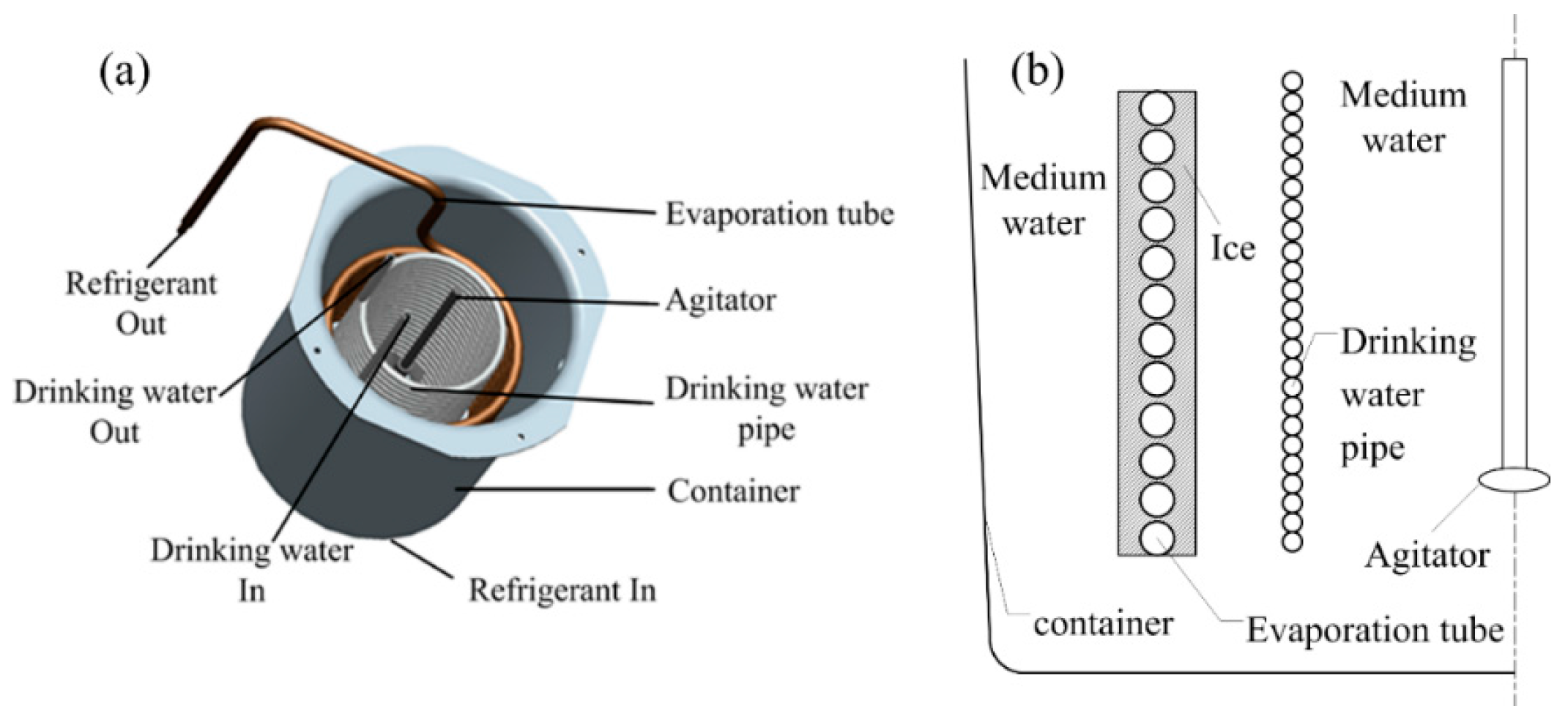
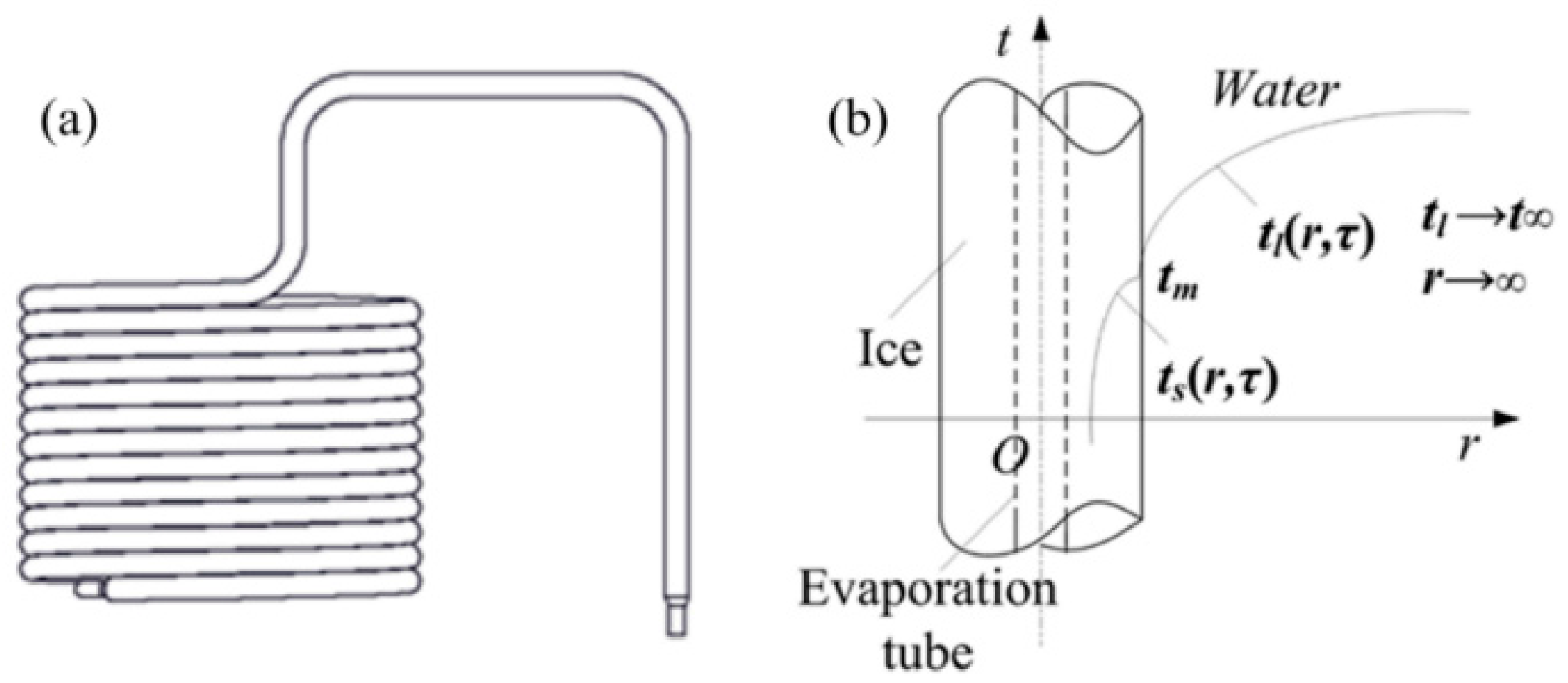




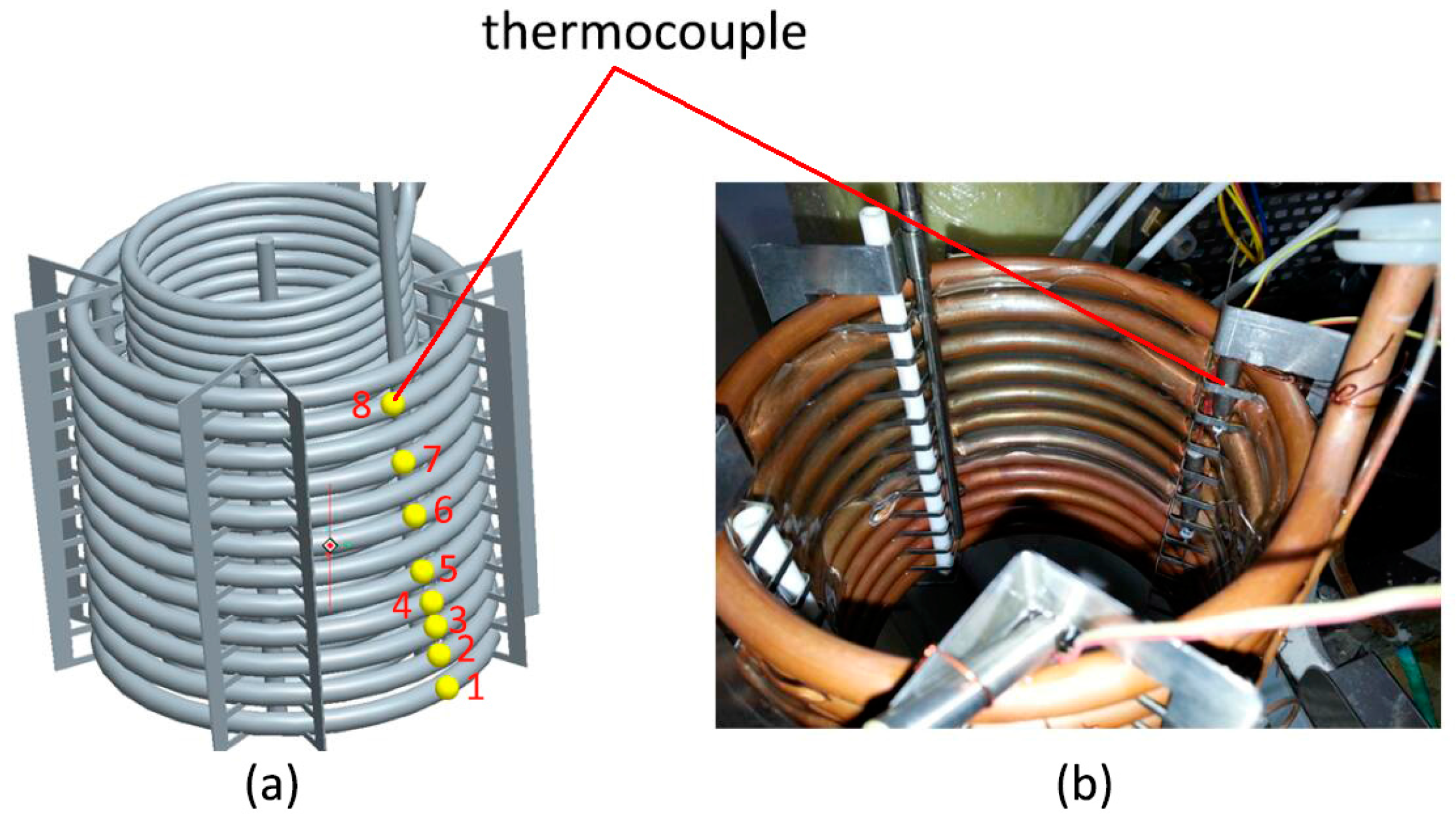
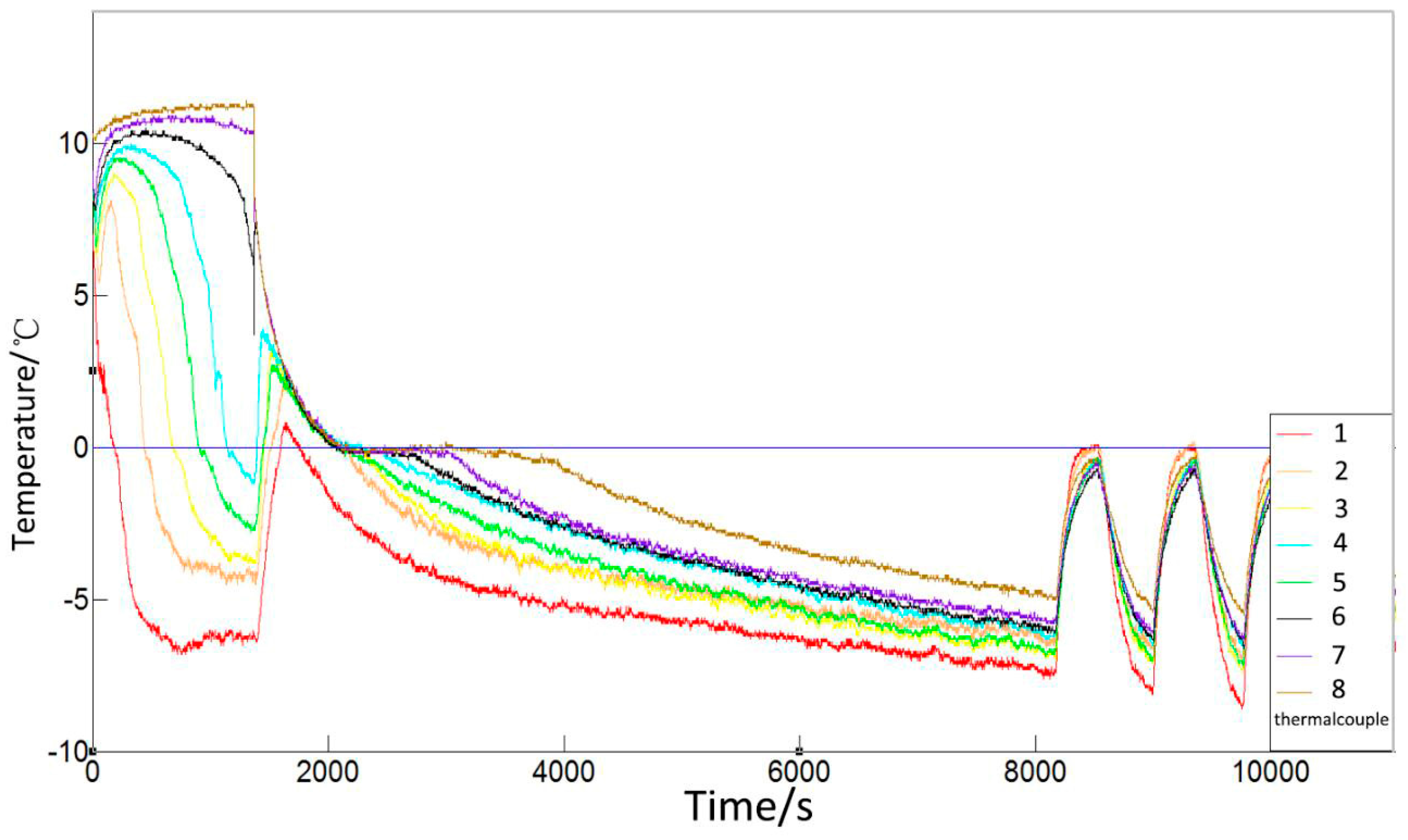
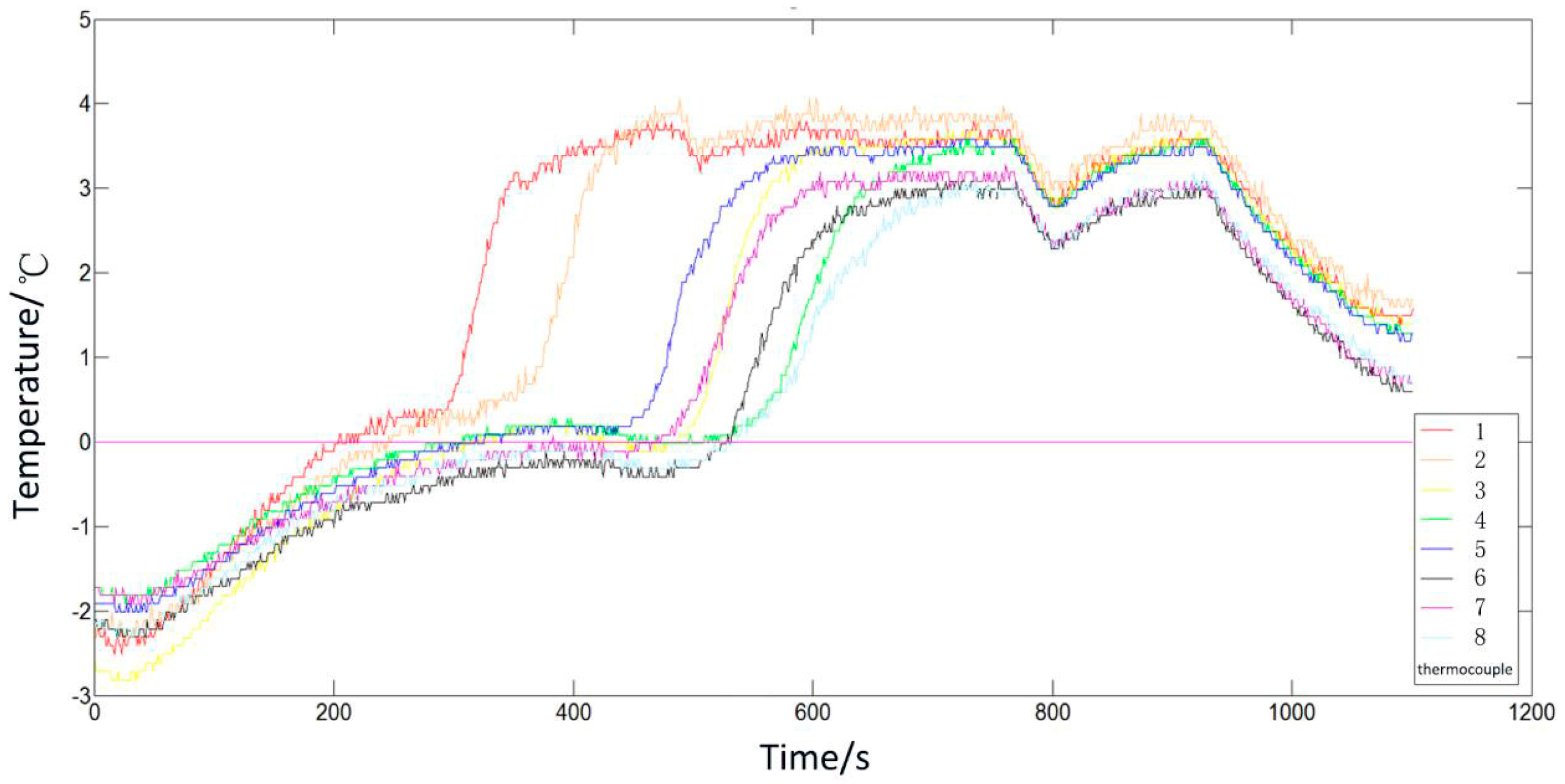
| Physical Parameters | Water | Ice |
|---|---|---|
| Density (kg/m3) | 999.9 | 913 |
| Specific heat capacity (J/kg·K) | 4212 | 2100 |
| Thermal conductivity (W/(m·K)) | 0.54 | 2.22 |
| Viscosity (Pa·s) | 0.0018 | - |
| Melting heat (J/kg) | 333,146 | 333,146 |
| Phase change point (K) | 273.16 | 273.16 |
© 2017 by the authors. Licensee MDPI, Basel, Switzerland. This article is an open access article distributed under the terms and conditions of the Creative Commons Attribution (CC BY) license (http://creativecommons.org/licenses/by/4.0/).
Share and Cite
Li, Y.; Yan, Z.; Yang, C.; Guo, B.; Yuan, H.; Zhao, J.; Mei, N. Study of a Coil Heat Exchanger with an Ice Storage System. Energies 2017, 10, 1982. https://doi.org/10.3390/en10121982
Li Y, Yan Z, Yang C, Guo B, Yuan H, Zhao J, Mei N. Study of a Coil Heat Exchanger with an Ice Storage System. Energies. 2017; 10(12):1982. https://doi.org/10.3390/en10121982
Chicago/Turabian StyleLi, Yan, Zhe Yan, Chao Yang, Bin Guo, Han Yuan, Jian Zhao, and Ning Mei. 2017. "Study of a Coil Heat Exchanger with an Ice Storage System" Energies 10, no. 12: 1982. https://doi.org/10.3390/en10121982





